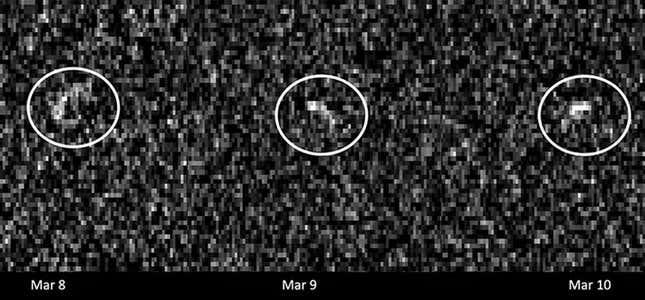Asteroid 99942 Apophis is fast approaching our home planet for an uncomfortably close encounter in 2029. In order to prepare for the rare event, NASA is calling for ideas for low cost missions to rendezvous with Apophis, but the space agency already has a pair of asteroid probes ready to take on the task.
NASA is hosting a workshop on Wednesday, February 7 “on innovative approaches to conduct missions during the Earth flyby of the asteroid Apophis in 2029.” The workshop is seeking ideas from the private space sector, other international space agencies and government agencies, and will feature a public briefing followed by one-on-one sessions.
Advertisement
Meanwhile, twin probes that were originally meant to study two separate binary asteroid systems are currently in storage at Lockheed Martin, the company that designed and built them. The pair of spacecraft were supposed to launch in August 2022, hitching a ride to space with the Psyche mission to explore a metal-rich asteroid. An unfortunate software glitch delayed Psyche’s launch two months before its liftoff, thereby affecting its ride-along missions.
Advertisement

Advertisement
Although Psyche later launched in October 2023, that launch window could not deliver the two spacecraft to the mission’s original targets. As a result, the Janus mission was taken off the launch manifest and stowed away, awaiting future funding that could possibly utilize the spacecraft for another mission.
The mission, selected as part of the agency’s Small, Innovative Missions for Planetary Exploration, or SIMPLEx, program, cost the space agency around $50 million to develop. The program “provides opportunities for low-cost, high risk science missions to ride-share with selected primary missions,” NASA wrote in its statement.
Advertisement
The Apophis flyby could be the perfect opportunity to repurpose the twin probes. “Essentially you would keep the spacecraft as is, what would change is the launch vehicle that you put them on because you have to send them to a different spot and you might, you know, drive it a little bit differently,” Daniel Scheeres, the principal investigator of the project and an astronomer at the University of Colorado, told Gizmodo. “It’s sort of like if you want to drive your car down the highway, or down a dirt road, you don’t change the car, but you might drive differently.”
Apophis is a near-Earth object that measures around 1,100 feet (335 meters) across. When it was first discovered in 2004, it was designated as a hazardous asteroids that could impact Earth. Later observations, however, reassured scientists that there’s no need to panic just yet, and that the asteroid has no chance of crashing into our planet for at least a century.
Advertisement
It will come within an eerily close distance of less than 20,000 miles (32,000 kilometers) from us on April 13, 2029. NASA wants to explore the asteroid to determine whether Earth’s gravitational field will have an impact on Apophis’ orientation and spin. Although there are some differences between Apophis and the original target of the Janus mission, “we would do the fly by and make the observations in a very similar manner,” Scheeres said.
In fact, another spacecraft, initially intended to examine a different asteroid, is already scheduled to visit Apophis. After dropping off a sample of asteroid Bennu in September 2023, the OSIRIS-REx spacecraft ventured off on another mission. NASA redirected the spacecraft, now renamed OSIRIS-APophis EXplorer (OSIRIS-APEX), to study Apophis during the asteroid’s 2029 flyby.
Advertisement
OSIRIS-APEX will arrive at the asteroid on April 13, 2029, and observe it for the next 18 months. NASA still wants to send a mission to Apophis before the Earth encounter to observe the changes it might have had on the asteroid.
“I don’t know exactly what they’re looking for,” Scheeres said, referring to the upcoming workshop. “I think they’re just trying to see what ideas are out there before making a decision,” he added. “Maybe the Janus spacecraft aren’t the best way of doing this…[NASA] can’t really tell until they hear from the whole community.”
Advertisement
Psyche’s delay triggered a review of operations at NASA’s Jet Propulsion Laboratory (JPL), which uncovered a host of issues related to budgeting and staffing. As a result of these issues at JPL, NASA also delayed the launch of its VERITAS (Venus Emissivity, Radio Science, InSAR, Topography, and Spectroscopy) probe indefinitely. The space agency is still trying to work through its budget as it prepares to send humans back to the Moon for its Artemis program, return samples from Mars as part of the ambitious Mars Sample Return, and further develop its Moon to Mars program. The Janus mission, as well as VERITAS, were unfortunate victims of ongoing constraints at NASA. The spacecraft are standing by for any future available use that would ensure the effort and cost put into them doesn’t go to waste.
There are still available pathways for Janus to reach its original targets, asteroids 1996 FG3 and 1991 VH. “We really liked the original targets, that would be great if we can get back to there but there are a lot of other compelling targets, including Apophis, that that we could use [the spacecraft] for,” Scheeres said.
Advertisement
For more spaceflight in your life, follow us on Twitter and bookmark Gizmodo’s dedicated Spaceflight Spaceflight page.
Services Marketplace – Listings, Bookings & Reviews